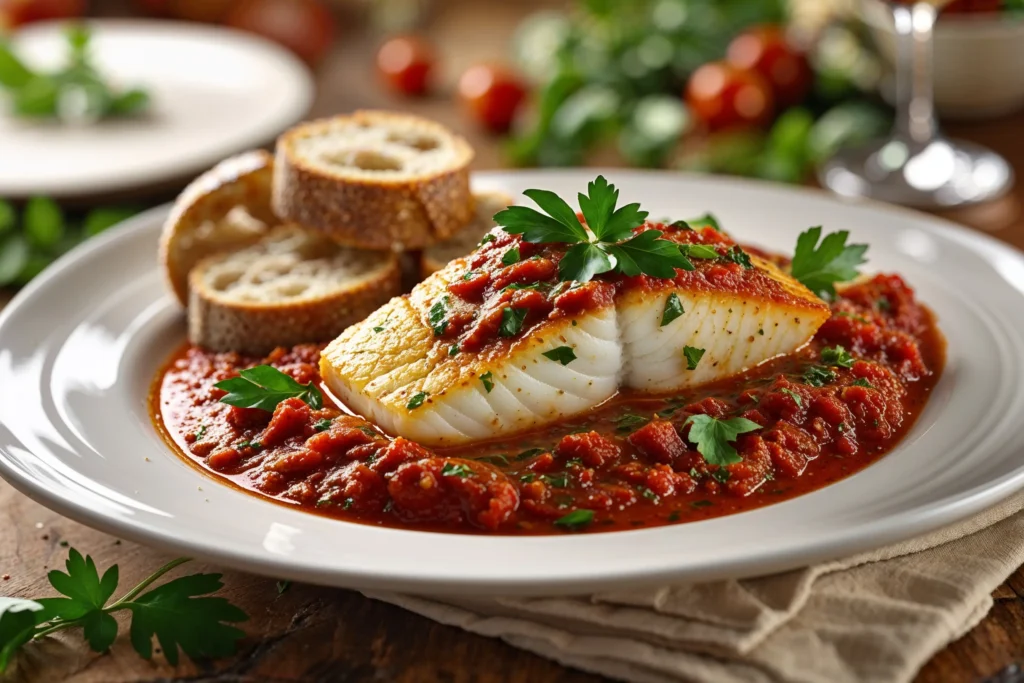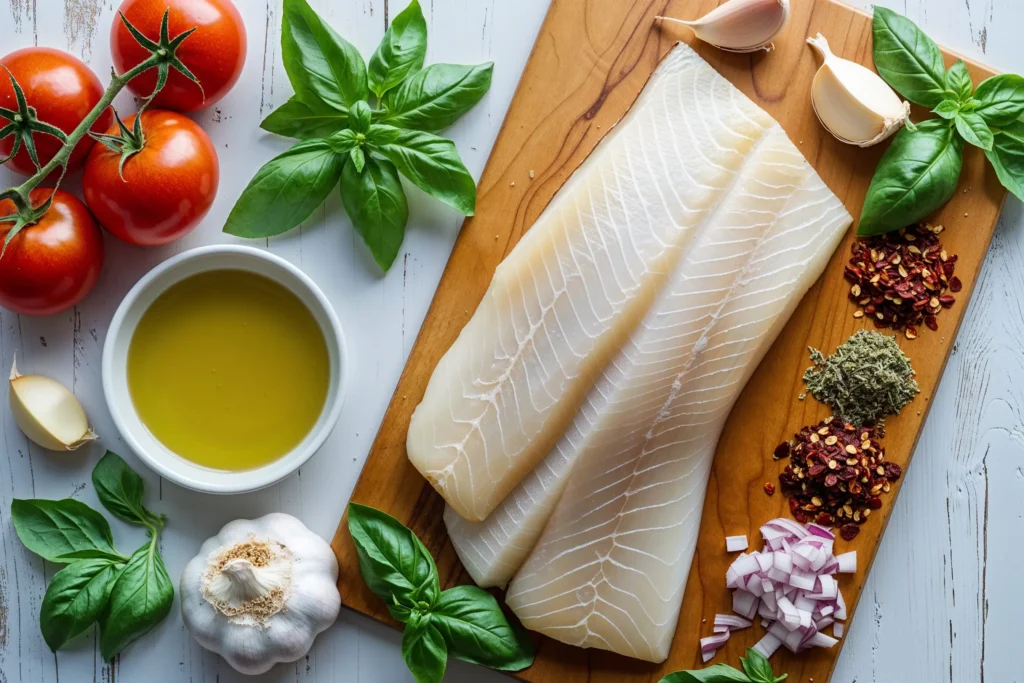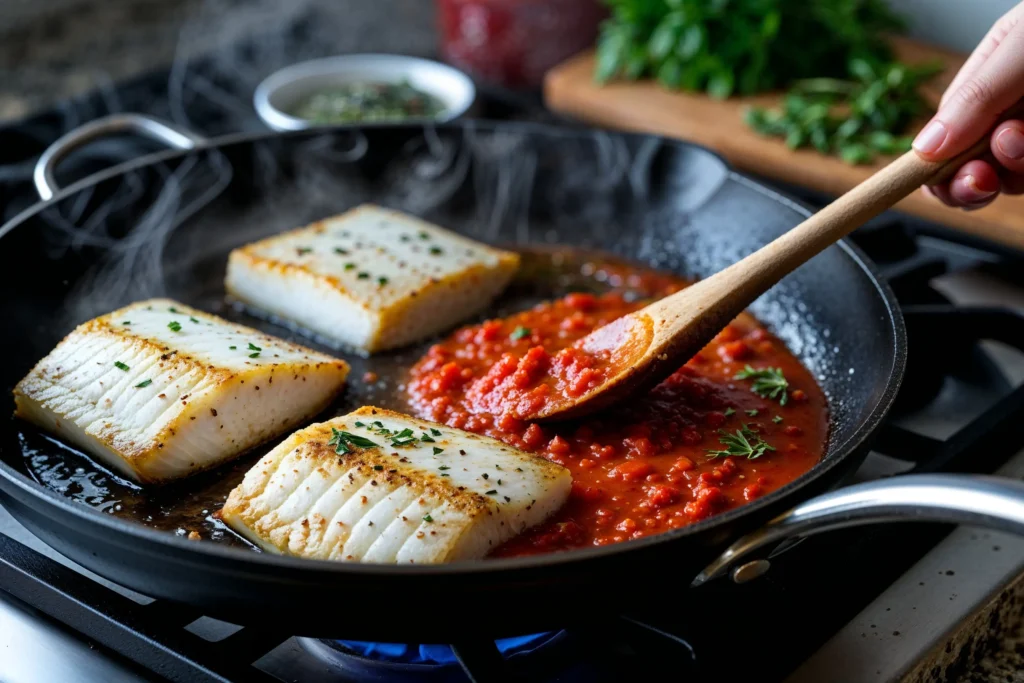Table of contents
Estimated reading time: 11 minutes
What is Halibut Marinara Sauce Recipe?
Halibut marinara sauce is a flavorful and versatile culinary creation that combines the tender, mild taste of halibut with the rich, savory notes of marinara sauce. This pairing offers a harmonious balance of delicate seafood with the robust and tangy flavors of tomatoes, garlic, and herbs. Often featured in Mediterranean-inspired cuisine, this dish showcases the best of land and sea in a single plate.
The foundation of this dish is halibut, a firm white fish known for its subtle, sweet flavor and tender texture. It pairs seamlessly with marinara sauce, which typically consists of ripe tomatoes, garlic, olive oil, and a medley of herbs such as basil and oregano. The sauce’s acidity complements the fish’s natural sweetness, creating a dynamic taste experience.
This recipe is both adaptable and easy to prepare, making it an excellent choice for home cooks and professionals alike. The process involves simmering marinara sauce to perfection while the halibut is gently cooked to maintain its texture and flavor. Often, additional ingredients like olives, capers, or fresh parsley are incorporated for added depth.
This dish is not only a feast for the palate but also provides a healthy option, as halibut is rich in protein and omega-3 fatty acids. Served over pasta, rice, or on its own, halibut marinara sauce is a dish that celebrates simplicity and freshness.
This Mediterranean-inspired dish is celebrated for its balance of tender seafood and rich tomato flavors, making it a versatile option for family dinners or special occasions. For more delicious seafood ideas, check out this simple marinara fish recipe.

Essential Ingredients for the Best Halibut Marinara Sauce
Creating a delicious Halibut Marinara Sauce Recipe requires a thoughtful selection of fresh and high-quality ingredients. These components work together to bring out the vibrant flavors of the dish while maintaining its natural balance and simplicity. Below is a list of essential ingredients, each playing a crucial role in the recipe’s success:
Key Ingredients:
- Halibut Fillets: Fresh halibut is the star of the dish, known for its tender, mild, and slightly sweet flavor. Opt for firm, white fillets to ensure the best results.
- Marinara Sauce: A rich, tangy tomato base made with ripe tomatoes, olive oil, garlic, and herbs such as basil and oregano forms the backbone of the dish. Homemade or high-quality store-bought options work well.
- Garlic: Fresh garlic adds depth and an aromatic quality that enhances the overall flavor.
- Olive Oil: Extra virgin olive oil provides a smooth and fruity undertone, tying the flavors together beautifully.
- Onion: Sautéed onions contribute a hint of sweetness and a subtle texture to the sauce.
- Herbs: Fresh basil and parsley bring freshness and a pop of color, while dried oregano adds earthy notes.
- Seasoning: Salt and freshly ground black pepper are essential for seasoning the fish and sauce to taste.
Optional Enhancements:
- Red Pepper Flakes: For those who enjoy a touch of heat, red pepper flakes offer a subtle spicy kick.
- Capers or Olives: These briny additions add complexity and contrast to the dish.
- White Wine: A splash of dry white wine can deepen the sauce’s flavor and add a layer of sophistication.

Using fresh, high-quality ingredients is key to crafting an authentic and satisfying halibut marinara sauce. These elements, when combined thoughtfully, create a dish that is as visually appealing as it is delicious.
Step-by-Step Halibut Marinara Sauce Recipe Guide
Preparing Halibut Marinara Sauce Recipe involves a straightforward process that highlights the natural flavors of its ingredients. Follow these steps to create a dish that is both satisfying and visually appealing.
1: Prepare the Halibut
- Begin by patting the halibut fillets dry with a paper towel. This helps the fish cook evenly and develop a delicate texture.
- Season both sides of the fillets with salt and freshly ground black pepper, setting them aside while you prepare the sauce.
2: Cook the Marinara Sauce
- Heat 2 tablespoons of extra virgin olive oil in a large skillet over medium heat.
- Add finely chopped onion and minced garlic, cooking until softened and fragrant, about 2-3 minutes.
- Pour in your marinara sauce, either homemade or store-bought, stirring to combine with the aromatics.
- If desired, add a splash of dry white wine or a pinch of red pepper flakes for an extra layer of flavor.
- Allow the sauce to simmer gently for 10 minutes, stirring occasionally to develop its full depth.
3: Cook the Halibut
- Heat another tablespoon of olive oil in a separate skillet over medium heat.
- Place the seasoned halibut fillets into the skillet, cooking for 3-4 minutes per side or until the fish flakes easily with a fork. Avoid overcooking to maintain the fish’s tenderness.
4: Combine and Serve
- Carefully transfer the cooked halibut fillets to the marinara sauce, spooning some sauce over the top. Allow the fish to sit in the sauce for 2-3 minutes to absorb its flavors.
- Garnish with fresh parsley and basil for a pop of color and aroma.
- Serve the dish immediately over pasta, rice, or with a side of crusty bread.

By following these steps, you can craft a delightful halibut marinara sauce that is rich in flavor and simple to prepare, perfect for any occasion.
Tips and Tricks for the Best Halibut Marinara Sauce
Crafting the perfect halibut marinara sauce requires attention to detail and a few simple strategies to elevate its flavor and texture. These tips will help you achieve a dish that is both flavorful and satisfying.
Choose Fresh Ingredients
- Always select fresh halibut fillets with a firm texture and a mild, clean aroma. Fresh fish is essential for the dish’s success.
- Opt for high-quality marinara sauce or make your own using ripe tomatoes, garlic, and fresh herbs for a rich, authentic taste.
Season Thoughtfully
- Season the halibut with salt and freshly ground black pepper just before cooking to highlight its natural sweetness.
- Adjust the seasoning of the marinara sauce to balance acidity and ensure it complements the fish perfectly.
Cooking Techniques
- Cook halibut fillets over medium heat to avoid overcooking, which can make the fish dry. A few minutes on each side should suffice until the fillets flake easily with a fork.
- Let the sauce simmer gently to meld the flavors together. Adding ingredients like garlic and onion at the beginning enhances the sauce’s depth.
Garnish and Pairings
- Finish the dish with a sprinkle of fresh parsley or basil for a vibrant, herbaceous touch.
- Pair the dish with a simple side like pasta, rice, or crusty bread to soak up the delicious sauce.
Experiment with Additions
- Consider adding olives, capers, or a splash of white wine to the sauce for added complexity. A touch of red pepper flakes can also bring a subtle heat.
With these tips, you can consistently create a halibut marinara sauce that is flavorful, tender, and visually appealing, making it an ideal choice for any meal.
Health Benefits of Halibut with Marinara Sauce
Halibut marinara sauce is not just a delightful culinary creation; it is also packed with a variety of health benefits that contribute to overall wellness. The combination of nutrient-rich halibut and wholesome marinara sauce makes this dish a smart choice for a balanced diet.
Nutritional Value of Halibut
- Halibut is a lean source of high-quality protein, essential for muscle repair and maintenance.
- It is rich in omega-3 fatty acids, which support heart health by reducing inflammation and improving cholesterol levels.
- The fish contains vital nutrients like vitamin D, selenium, and magnesium, which are important for bone health, immune function, and energy production.
Benefits of Marinara Sauce
- Made primarily from tomatoes, marinara sauce is an excellent source of antioxidants, particularly lycopene, which helps combat oxidative stress and may reduce the risk of certain cancers.
- The garlic and onions in the sauce contain compounds that promote heart health and boost immunity.
- Olive oil, often included in marinara, provides healthy monounsaturated fats that support cardiovascular health and help regulate blood sugar levels.
Low-Calorie, High-Flavor Option
- This dish is naturally low in calories while being packed with flavor, making it suitable for those managing their weight.
- The absence of heavy cream or butter ensures it remains a heart-friendly meal choice.
Versatile Pairings for Balanced Meals
- When paired with whole-grain pasta, brown rice, or roasted vegetables, halibut marinara sauce provides a well-rounded meal filled with fiber, vitamins, and minerals.
By combining the health benefits of fresh seafood with the goodness of tomatoes, garlic, and herbs, this dish delivers both taste and nutrition in every bite.
Variations of Tomato-Based Halibut Marinara Dish
While the classic Halibut Marinara Sauce Recipe is a satisfying dish on its own, adding slight variations can offer new flavors and textures to suit different preferences. These adaptations allow you to personalize the recipe without compromising its core appeal.
Seafood Medley Marinara
- Add shrimp, scallops, or clams alongside halibut to create a seafood medley. The variety of textures and flavors adds depth to the dish while keeping it rooted in its original concept.
- Adjust the cooking time for each type of seafood to avoid overcooking.
Vegetable-Enriched Marinara
- Incorporate finely chopped vegetables such as zucchini, bell peppers, or spinach into the marinara sauce. These additions provide added nutrients and subtle sweetness.
- Sauté the vegetables with garlic and onions before combining them with the sauce.
Spicy Halibut Marinara
- For those who enjoy heat, add red pepper flakes, diced chili peppers, or a touch of hot sauce to the marinara. The spice complements the mildness of halibut beautifully.
Creamy Tomato Twist
- Stir in a small amount of heavy cream or coconut milk at the end of cooking to create a creamy tomato base. This variation offers a richer texture and a milder tomato flavor.
Herb-Infused Marinara
- Experiment with different herbs such as thyme, rosemary, or tarragon to introduce unique aromatic notes to the sauce. Fresh herbs can be added as a garnish or stirred into the sauce.
Lemon-Garlic Marinara
- Add freshly squeezed lemon juice and a generous amount of garlic for a zesty, citrus-forward version of the dish. The acidity of the lemon enhances the flavors of both the fish and the sauce.
These variations provide fresh and creative ways to enjoy halibut marinara sauce, allowing you to tailor the dish to specific tastes or dietary needs while maintaining its core simplicity and appeal.
Common Mistakes in Halibut Marinara Recipes and How to Avoid Them
Preparing Halibut Marinara Sauce Recipe may seem straightforward, but a few missteps can impact the final result. By being aware of these common mistakes and how to avoid them, you can achieve a dish that is both flavorful and well-prepared.
Overcooking the Halibut
- Halibut is a delicate fish that becomes dry and tough if overcooked. To avoid this, cook it for just a few minutes on each side until it flakes easily with a fork. Use medium heat to maintain control over the cooking process.
Using Low-Quality Ingredients
- The freshness of the fish and the quality of the marinara sauce significantly influence the dish’s taste. Always opt for fresh halibut with a mild aroma and bright, firm flesh. When possible, prepare marinara sauce from scratch using ripe tomatoes and fresh herbs.
Neglecting to Season Properly
- Insufficient seasoning can leave the dish tasting bland, while over-seasoning can overpower the delicate flavors. Taste the sauce as it cooks and adjust the seasoning gradually. Lightly season the fish to complement, not overshadow, the sauce.
Skipping the Preheat
- Failing to preheat the skillet can cause uneven cooking or sticking. Always heat the pan with olive oil before adding the halibut to achieve a golden crust and prevent sticking.
Rushing the Sauce
- Marinara sauce needs time to develop its flavors. Allow the sauce to simmer gently for at least 10 minutes before adding the fish. Avoid boiling, as this can create an overly acidic taste.
Overloading the Pan
- Cooking too many fillets at once can lower the pan’s temperature, resulting in unevenly cooked fish. Work in batches if needed, giving each fillet enough space to cook properly.
Serving Without Resting
- After combining the halibut with the marinara sauce, let it rest for a couple of minutes. This allows the flavors to meld, enhancing the dish’s overall taste.
By keeping these tips in mind, you can avoid common pitfalls and consistently prepare a halibut marinara sauce that is perfectly cooked and brimming with balanced flavors.
